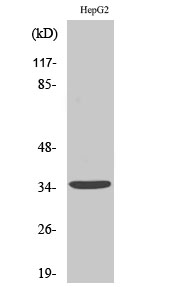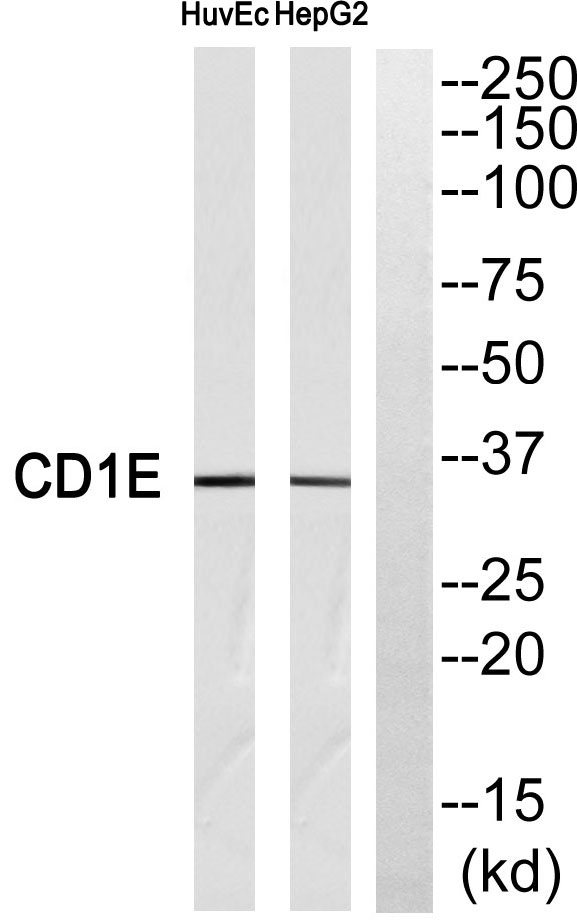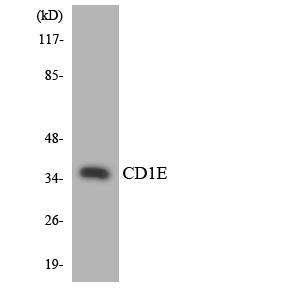CD1e Polyclonal Antibody
- Catalog No.:YT0736
- Applications:WB;ELISA
- Reactivity:Human
- Target:
- CD1E
- Fields:
- >>Tight junction;>>Hematopoietic cell lineage;>>Amoebiasis
- Gene Name:
- CD1E
- Protein Name:
- T-cell surface glycoprotein CD1e membrane-associated
- Human Gene Id:
- 913
- Human Swiss Prot No:
- P15812
- Immunogen:
- The antiserum was produced against synthesized peptide derived from human CD1E. AA range:217-266
- Specificity:
- CD1e Polyclonal Antibody detects endogenous levels of CD1e protein.
- Formulation:
- Liquid in PBS containing 50% glycerol, 0.5% BSA and 0.02% sodium azide.
- Source:
- Polyclonal, Rabbit,IgG
- Dilution:
- WB 1:500 - 1:2000. ELISA: 1:10000. Not yet tested in other applications.
- Purification:
- The antibody was affinity-purified from rabbit antiserum by affinity-chromatography using epitope-specific immunogen.
- Concentration:
- 1 mg/ml
- Storage Stability:
- -15°C to -25°C/1 year(Do not lower than -25°C)
- Other Name:
- CD1E;T-cell surface glycoprotein CD1e; membrane-associated;hCD1e;R2G1;CD antigen CD1e
- Observed Band(KD):
- 36kD
- Background:
- This gene encodes a member of the CD1 family of transmembrane glycoproteins, which are structurally related to the major histocompatibility complex (MHC) proteins and form heterodimers with beta-2-microglobulin. The CD1 proteins mediate the presentation of primarily lipid and glycolipid antigens of self or microbial origin to T cells. The human genome contains five CD1 family genes organized in a cluster on chromosome 1. The CD1 family members are thought to differ in their cellular localization and specificity for particular lipid ligands. The protein encoded by this gene localizes within Golgi compartments, endosomes, and lysosomes, and is cleaved into a stable soluble form. The soluble form is required for the intracellular processing of some glycolipids into a form that can be presented by other CD1 family members. Many alternatively spliced transcript variants encoding different isoforms have been desc
- Function:
- function:Required for the presentation of glycolipid antigens on the cell surface.,PTM:Mono-ubiquitinated.,PTM:Proteolytically cleaved in endosomes to yield a soluble form.,similarity:Contains 1 Ig-like (immunoglobulin-like) domain.,subcellular location:Predominantly localized in the trans-Golgi network in immature dendritic cells, and as a cleaved, soluble protein in the lysosome lumen of mature dendritic cells.,subunit:Heterodimer with B2M (beta-2-microglobulin).,tissue specificity:Expressed on cortical thymocytes, dendritic cells, Langerhans cells, on certain T-cell leukemias, and in various other tissues.,
- Subcellular Location:
- [T-cell surface glycoprotein CD1e, membrane-associated]: Golgi apparatus membrane; Single-pass type I membrane protein. Early endosome. Late endosome. Predominantly localized in the trans-Golgi network in immature dendritic cells, and as a cleaved, soluble protein in the lysosome lumen of mature dendritic cells.; [T-cell surface glycoprotein CD1e, soluble]: Lysosome lumen.
- Expression:
- Expressed on cortical thymocytes, dendritic cells, Langerhans cells, on certain T-cell leukemias, and in various other tissues.
- June 19-2018
- WESTERN IMMUNOBLOTTING PROTOCOL
- June 19-2018
- IMMUNOHISTOCHEMISTRY-PARAFFIN PROTOCOL
- June 19-2018
- IMMUNOFLUORESCENCE PROTOCOL
- September 08-2020
- FLOW-CYTOMEYRT-PROTOCOL
- May 20-2022
- Cell-Based ELISA│解您多样本WB检测之困扰
- July 13-2018
- CELL-BASED-ELISA-PROTOCOL-FOR-ACETYL-PROTEIN
- July 13-2018
- CELL-BASED-ELISA-PROTOCOL-FOR-PHOSPHO-PROTEIN
- July 13-2018
- Antibody-FAQs
- Products Images

- Western Blot analysis of various cells using CD1e Polyclonal Antibody

- Western blot analysis of CD1E Antibody. The lane on the right is blocked with the CD1E peptide.

- Western blot analysis of the lysates from RAW264.7cells using CD1E antibody.



